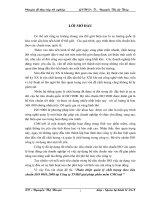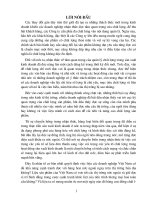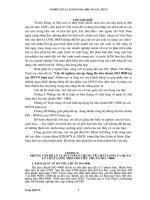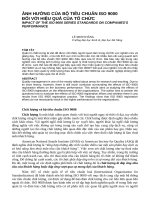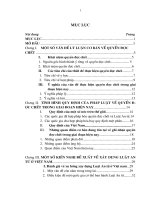Tiêu chuẩn iso 00123 2001
Bạn đang xem bản rút gọn của tài liệu. Xem và tải ngay bản đầy đủ của tài liệu tại đây (184.64 KB, 14 trang )
INTERNATIONAL
STANDARD
ISO
123
Third edition
2001-05-15
Rubber latex — Sampling
Latex de caoutchouc — Échantillonnage
--`,,```,,,,````-`-`,,`,,`,`,,`---
Reference number
ISO 123:2001(E)
© ISO 2001
Copyright International Organization for Standardization
Provided by IHS under license with ISO
No reproduction or networking permitted without license from IHS
Not for Resale
ISO 123:2001(E)
PDF disclaimer
This PDF file may contain embedded typefaces. In accordance with Adobe's licensing policy, this file may be printed or viewed but shall not be
edited unless the typefaces which are embedded are licensed to and installed on the computer performing the editing. In downloading this file,
parties accept therein the responsibility of not infringing Adobe's licensing policy. The ISO Central Secretariat accepts no liability in this area.
Adobe is a trademark of Adobe Systems Incorporated.
--`,,```,,,,````-`-`,,`,,`,`,,`---
Details of the software products used to create this PDF file can be found in the General Info relative to the file; the PDF-creation parameters
were optimized for printing. Every care has been taken to ensure that the file is suitable for use by ISO member bodies. In the unlikely event
that a problem relating to it is found, please inform the Central Secretariat at the address given below.
© ISO 2001
All rights reserved. Unless otherwise specified, no part of this publication may be reproduced or utilized in any form or by any means, electronic or mechanical, including photocopying and microfilm, without permission in writing from either ISO at the address below or ISO's member body in the country of the requester.
ISO copyright office
Case postale 56 • CH-1211 Geneva 20
Tel. + 41 22 749 01 11
Fax + 41 22 749 09 47
Web www.iso.ch
Printed in Switzerland
ii
Copyright International Organization for Standardization
Provided by IHS under license with ISO
No reproduction or networking permitted without license from IHS
© ISO 2001 – All rights reserved
Not for Resale
ISO 123:2001(E)
Contents
Page
1
Scope ...............................................................................................................................................................
1
2
Normative references .......................................................................................................................................
1
3
Terms and definitions ........................................................................................................................................
1
4
Principle ............................................................................................................................................................
2
5
Apparatus .........................................................................................................................................................
2
6
Sampling ...........................................................................................................................................................
3
7
Labelling the laboratory sample and the test sample .......................................................................................
7
8
Sampling report ................................................................................................................................................
8
--`,,```,,,,````-`-`,,`,,`,`,,`---
Copyright International
Organization
Standardization
© ISO
2001 –forAll
rights reserved
Provided by IHS under license with ISO
No reproduction or networking permitted without license from IHS
iii
Not for Resale
ISO 123:2001(E)
Foreword
ISO (the International Organization for Standardization) is a worldwide federation of national standards bodies (ISO
member bodies). The work of preparing International Standards is normally carried out through ISO technical committees. Each member body interested in a subject for which a technical committee has been established has the
right to be represented on that committee. International organizations, governmental and non-governmental, in liaison with ISO, also take part in the work. ISO collaborates closely with the International Electrotechnical Commission
(IEC) on all matters of electrotechnical standardization.
International Standards are drafted in accordance with the rules given in the ISO/IEC Directives, Part 3.
Draft International Standards adopted by the technical committees are circulated to the member bodies for voting.
Publication as an International Standard requires approval by at least 75 % of the member bodies casting a vote.
Attention is drawn to the possibility that some of the elements of this International Standard may be the subject of
patent rights. ISO shall not be held responsible for identifying any or all such patent rights.
--`,,```,,,,````-`-`,,`,,`,`,,`---
International Standard ISO 123 was prepared by Technical Committee ISO/TC 45, Rubber and rubber products,
Subcommittee SC 3, Raw materials (including latex) for use in the rubber industry.
This third edition cancels and replaces the second edition (ISO 123:1985), which has been technically revised. The
principal differences lie in more precise definitions and specifications for the frequency of sampling. In addition, the
method of homogenizing and sampling latex in drums fitted with bungs has been modified to take account of practical
considerations.
iv
Copyright International Organization for Standardization
Provided by IHS under license with ISO
No reproduction or networking permitted without license from IHS
© ISO 2001 – All rights reserved
Not for Resale
INTERNATIONAL STANDARD
ISO 123:2001(E)
Rubber latex — Sampling
WARNING — Persons using this International Standard should be familiar with normal laboratory practice.
This standard does not purport to address all of the safety problems, if any, associated with its use. It is the
responsibility of the user to establish appropriate safety and health practices and to ensure compliance with
any national regulatory conditions.
1 Scope
This International Standard specifies procedures for sampling natural rubber latex concentrate and for sampling synthetic rubber latices and artificial latices. It is also suitable for sampling rubber latex contained in drums, tank cars or
tanks. The procedures may also be used for sampling plastics dispersions.
2 Normative references
The following normative documents contain provisions which, through reference in this text, constitute provisions of
this International Standard. For dated references, subsequent amendments to, or revisions of, any of these publications do not apply. However, parties to agreements based on this International Standard are encouraged to investigate the possibility of applying the most recent editions of the normative documents indicated below. For undated
references, the latest edition of the normative document referred to applies. Members of ISO and IEC maintain registers of currently valid International Standards.
ISO 124:1997, Latex, rubber — Determination of total solids content.
ISO 706:1985, Rubber latex — Determination of coagulum content (sieve residue).
ISO 3310-1:2000, Test sieves — Technical requirements and testing — Part 1: Test sieves of metal wire cloth.
ISO 15528:2000, Paints, varnishes and raw materials for paints and varnishes — Sampling.
3 Terms and definitions
For the purposes of this International Standard, the following terms and definitions apply.
3.1
lot
a definite quantity of latex processed or produced under conditions which are presumed uniform
NOTE A lot may be in one or more containers or vessels. For example, it may consist of several drums of latex.
3.2
sample
a quantity of latex that has been drawn from a lot
3.3
laboratory sample
a quantity of latex intended for laboratory inspection and testing and that is representative of the lot
--`,,```,,,,````-`-`,,`,,`,`,,`---
Copyright International
Organization
Standardization
© ISO
2001 –forAll
rights reserved
Provided by IHS under license with ISO
No reproduction or networking permitted without license from IHS
1
Not for Resale
ISO 123:2001(E)
3.4
test sample
a quantity of latex suitable for testing, obtained by straining the laboratory sample
NOTE The laboratory sample, not the test sample, is used for the determination of coagulum content (see 6.5.5).
3.5
test portion
a quantity of latex taken from the test sample (3.4) or laboratory sample (3.3), for the purpose of a single specific test,
for example the amount actually weighed out from the test sample for a single determination of total solids content
3.6
coagulum content/sieve residue
coarse foreign matter and flocculated rubber retained under the conditions of the test (ISO 706) on a filter with average aperture width of 180 µm ± 10 µm complying with ISO 3310-1
NOTE In the context of examination of latex shipments, bulk deliveries, etc., this is what is generally understood by “coagulum”.
Pieces of latex skin and coagulated rubber should not be included in the laboratory sample.
4 Principle
A representative laboratory sample is taken from the bulk of the latex. The test sample is prepared by straining the
laboratory sample.
5 Apparatus
No part of the equipment to be immersed in the latex shall contain copper.
5.1 Stirrer, for homogenization of latex in drums.
For open-headed drums, use either 5.1.1 or 5.1.2. For drums fitted with a bung, see 6.4.1.4.
5.1.1 Plunger, consisting of a perforated, chrome-plated or stainless-steel disc of diameter approximately 150 mm,
with smooth-edged holes of diameter approximately 10 mm.
5.1.2 Motor-driven stirrer, capable of operating at a speed of 5 rad/s to 21 rad/s (50 r/min to 200 r/min).
A suitable type of motor-driven stirrer consists of a stainless-steel propeller of 110 mm minimum diameter, mounted
on a stainless-steel shaft sufficiently long for the propeller to be at a distance of about one-tenth the depth of the latex
from the bottom of the drum.
If desired, two propellers may be used on the same shaft, in which case the lower one shall meet the foregoing requirements as regards position. The rotational frequency shall be such as to give a brisk turnover without creating a
vortex.
5.1.3 Motor-driven drum roller (optional, see 6.4.1.5), capable of rotating a drum at approximately 1 rad/s
(10 r/min).
5.2 Sampling devices, suitable for the removal of an approximately 1 dm3 representative sample from a known
depth in the latex. Such devices shall be constructed of materials inert to latex.
5.2.1 Sampling tubes for latex in drums
Use either 5.2.1.1 or 5.2.1.2.
5.2.1.1 Sampling tube, of material inert to the latex, such as glass, stainless steel or inert plastic, having an internal diameter of 10 mm to 15 mm and a length of at least 1 m, open at both ends and having a stopper for closing the
upper end while withdrawing it from the latex.
--`,,```,,,,````-`-`,,`
2
Copyright International Organization for Standardization
Provided by IHS under license with ISO
No reproduction or networking permitted without license from IHS
© ISO 2001 – All rights reserved
Not for Resale
ISO 123:2001(E)
NOTE Inserting a tube open at both ends into the latex effectively provides a cross-section of the latex at all depths as a sample.
5.2.1.2 Sampling tube, stainless steel, of internal diameter approximately 25 mm and length at least 1 m, the bottom of which can be opened or closed by remote control. A drawing of a suitable device is given in Figure 1.
5.2.2 Sampling devices for latex in tank cars or tanks
Use 5.2.2.1 if the depth of the latex is 3 m or more. Use either 5.2.2.1 or 5.2.2.2 if the depth is less than 3 m.
5.2.2.1 Cylindrical stainless-steel vessel, of capacity approximately 1 dm3 , closed by a lid or bung that can be
opened by remote control. Such a vessel may be rigidly mounted for insertion to the required depth. A device similar
to that shown in Figure 2 is suitable. A variety of other suitable devices for sampling are given in ISO 15528.
5.2.2.2 Sampling tube, stainless steel, of internal diameter 25 mm, similar to 5.2.1.2 but length 3 m, the bottom of
which can be opened or closed by remote control.
5.3 Beakers, of capacity 2 dm3 , to receive the latex from the sampling tube or vessel. The beakers shall be shockresistant and have a smooth inner surface that is chemically inert to latex.
5.4 Sample bottles, of capacity 1 dm3 , with screw caps. The bottles shall have a smooth inner surface and be
made of material that is chemically resistant to latex. Glass and some types of plastic are suitable materials. Thin
flexible containers shall not be used.
NOTE For purposes of trans-shipment, narrow-necked containers with a deep thread are preferable.
5.5 Filter, of stainless-steel wire or synthetic cloth inert to latex, with an average aperture width of
180 µm ± 10 µm, complying with ISO 3310-1.
6 Sampling
6.1 General
At all stages of sampling, avoid introducing air into the latex and keep exposure of the latex to air to a minimum.
--`,,```,,,,````-`-`,,`,,`,`,,`---
6.2 Frequency of sampling
6.2.1 Unless otherwise agreed, sampling shall be carried out at the frequency specified in 6.2.2 and 6.2.3.
6.2.2 Every lot shall be sampled.
6.2.3 Where a lot has been divided between a number of distinct containers (e.g. drums), samples shall be taken
from 10 % of the containers with a minimum of one and rounded up to the nearest whole number (i.e. two from
twelve, seven from sixty-four, etc.).
Select the containers from which the samples are to be withdrawn at random throughout the consignment.
6.3 Preliminary examination
Examine the latex visually, and record the presence of creaming, gross coagulum, skin and foreign matter.
Copyright International
Organization
Standardization
© ISO
2001 –forAll
rights reserved
Provided by IHS under license with ISO
No reproduction or networking permitted without license from IHS
3
Not for Resale
--`,,```,,,,````-`-`,,`,,`,`,,`---
ISO 123:2001(E)
Key
1
2
3
4
5
Handle
Spring
Tube
Guides for valve rod
Simple valve
Figure 1 — Sampling tube for drums, tank cars and smaller tanks (not to scale)
4
Copyright International Organization for Standardization
Provided by IHS under license with ISO
No reproduction or networking permitted without license from IHS
© ISO 2001 – All rights reserved
Not for Resale
ISO 123:2001(E)
Key
1
2
3
4
a
Handle (manual compression opens lid)
Rods
Lid
Container of appropriate size
Suitable length for taking sample
Construction material: stainless steel
Figure 2 — Example of a latex-sampling device
--`,,```,,,,````-`-`,,`,,`,`,,`---
Copyright International
Organization
Standardization
© ISO
2001 –forAll
rights reserved
Provided by IHS under license with ISO
No reproduction or networking permitted without license from IHS
5
Not for Resale
ISO 123:2001(E)
6.4 Sampling from drums
6.4.1 Homogenization
6.4.1.1 Homogenize the latex manually as specified in 6.4.1.2 or mechanically as specified in 6.4.1.3 or, if appropriate, by means of a drum roller as specified in 6.4.1.5.
6.4.1.2 If the drum is of the open-head type, remove the end head and agitate the contents for at least 5 min, preferably by means of a perforated stainless-steel plunger (5.1.1).
6.4.1.3 Alternatively, agitate the contents of the drum by means of the motor-driven stirrer (5.1.2) for 10 min to homogenize the latex. Avoid excessive stirring.
6.4.1.4 If the drum is of the closed-head type fitted with a bung and contains less than 2 % air space, then manual
or mechanical homogenization is impractical. Lay the drum on its side and roll it to and fro briskly for not less than
10 min. Turn the drum so that it is standing on the end which was formerly uppermost and allow to stand for about
15 min, then repeat the rolling operation for a further 10 min.
6.4.1.5 Alternatively, if a single drum is to be sampled it is permissible to homogenize the latex by rolling the drum
on a drum roller for 24 h at about 1 rad/s (10 r/min).
6.4.2 Taking the laboratory sample (see 3.3)
6.4.2.1 General
After the latex has been homogenized (see 6.4.1), take the sample without delay as specified in 6.4.2.2 or 6.4.2.3,
using a clean, dry sampling tube (5.2.1). Take care to avoid the inclusion of any gross coagulum or skin with the
sample.
6.4.2.2 Sampling from a single drum
Insert the sampling tube (5.2.1), open at both ends, slowly into the drum until it reaches the bottom. Then close the
upper end of the tube with the stopper, withdraw it and transfer the contents to a clean, dry sample bottle (5.4). Repeat the operation until sufficient latex has been obtained to fill the sample bottle, leaving an air space of 2 % to 5 %
of the volume (to allow for thermal expansion), and screw the cap firmly onto the bottle.
NOTE It is important that the sample bottle is almost full and airtight.
6.4.2.3 Sampling from several drums
Where sampling of the same lot of latex from several drums is to be carried out, for example in 10 % sampling (see
6.2.3), and it has been agreed that the samples may be blended, the amount of latex withdrawn from each drum may
be reduced proportionately. In this case, the individual samples shall be combined in a beaker (5.3) and stirred briefly
to ensure uniformity and the resultant laboratory samples bottled (multiple samples may be required, for example for
arbitration).
6.5 Sampling from tank cars and tanks
Samples are initially taken from different depths to ensure that the latex is homogeneous.
NOTE For fixed tanks, establishing suitable conditions which result in homogeneity will make it unnecessary to check for
homogeneity each time a sample is taken.
6
Copyright International Organization for Standardization
Provided by IHS under license with ISO
No reproduction or networking permitted without license from IHS
© ISO 2001 – All rights reserved
Not for Resale
--`,,```,,,,````-`-`,,`,,`,`,,`---
6.5.1 General
ISO 123:2001(E)
6.5.2 Sampling operation
6.5.2.1 Use the sampling vessel (5.2.2.1) or sampling tube (5.2.2.2) as appropriate.
6.5.2.2 Operate the sampling vessel (5.2.2.1) by lowering it with the lid in place into the latex to the required depth
and then opening the lid. Allow a few seconds for the vessel to fill, then close the lid. Withdraw the vessel and transfer
the contents to a beaker (5.3). Transfer the latex to a sample bottle (5.4) leaving an air space of 2 % to 5 %. Screw
the cap firmly onto the bottle.
6.5.2.3 Operate the sampling tube (5.2.2.2) by inserting it with the bottom closed into the latex to the required depth
and then open the bottom of the tube. After the tube has filled with latex, close the bottom and withdraw the tube.
Transfer the contents of the tube into a beaker (5.3) and from the beaker to the sample bottle, leaving an air space of
2 % to 5 %. Screw the cap firmly onto the bottle.
6.5.3 Testing for homogeneity
--`,,```,,,,````-`-`,,`,,`,`,,`---
Take separate samples approximately 100 mm from the top surface and 100 mm from the bottom surface of the latex.
Strain the laboratory samples through the filter (5.5) and determine their total solids by the method specified in
ISO 124. If the results obtained from the top and bottom samples do not agree within 0,5 % (by mass) total solids, rehomogenize the complete lot with an efficient mechanical stirrer or by pumping the latex around until samples taken
from the top and the bottom agree within this tolerance.
6.5.4 Taking the laboratory sample
After the degree of homogeneity specified in 6.5.3 has been achieved, take three samples of similar volume, the first,
approximately halfway between the top and centre of the latex, the second from the centre of the latex and the third
approximately halfway between the centre and bottom of the latex. Combine the three samples in a beaker (5.3) and
stir, then transfer the resultant laboratory sample to a sample bottle (5.4).
NOTE If the sampling tube (5.2.2.2) is used, a single sample may be taken by inserting the tube with the bottom end held open
to the bottom of the latex and then closing the bottom of the tube before withdrawing it from the latex.
6.5.5 Coagulum content
The coagulum content (ISO 706) shall be determined on the laboratory sample (see 3.3).
6.6 Preparation of the test sample
Stir the laboratory sample carefully and strain it through a clean, dry filter (5.5) into a beaker (5.3). Transfer the
strained latex to another sample bottle (5.4), leaving an air space of 2 % to 5 %, and screw the cap firmly on the
bottle.
7 Labelling the laboratory sample and the test sample
The samples shall be clearly labelled and contain on the label the following information:
a) a description of the material;
b) the size and particulars of the consignment (tank-wagon, tank, ship, barrel or drum);
c) the designation “laboratory sample” or “test sample” and the reference number of the sample;
d) the consignor;
e) the place of sampling;
f)
the date of sampling;
g) the name of the sampler.
Copyright International
Organization
Standardization
© ISO
2001 –forAll
rights reserved
Provided by IHS under license with ISO
No reproduction or networking permitted without license from IHS
7
Not for Resale
ISO 123:2001(E)
8 Sampling report
The sampling report shall contain the following information:
a) a reference to this International Standard;
b) all details necessary for the identification of the material sampled;
c) the frequency of sampling;
d) a record of creaming, visible gross coagulum, skin and foreign matter (if any) present in the original container;
e) any unusual features noted during the sampling;
f)
a record whether or not the tank car or tank was initially homogeneous and the action taken to achieve
homogeneity;
g) any operation not included in this International Standard or regarded as optional.
--`,,```,,,,````-`-`,,`,,`,`,,`---
8
Copyright International Organization for Standardization
Provided by IHS under license with ISO
No reproduction or networking permitted without license from IHS
© ISO 2001 – All rights reserved
Not for Resale
--`,,```,,,,````-`-`,,`,,`,`,,`---
Copyright International Organization for Standardization
Provided by IHS under license with ISO
No reproduction or networking permitted without license from IHS
Not for Resale
--`,,```,,,,````-`-`,,`,,`,`,,`---
ISO 123:2001(E)
ICS 83.040.10
Price based on 8 pages
© ISO 2001 – All rights reserved
Copyright International Organization for Standardization
Provided by IHS under license with ISO
No reproduction or networking permitted without license from IHS
Not for Resale
